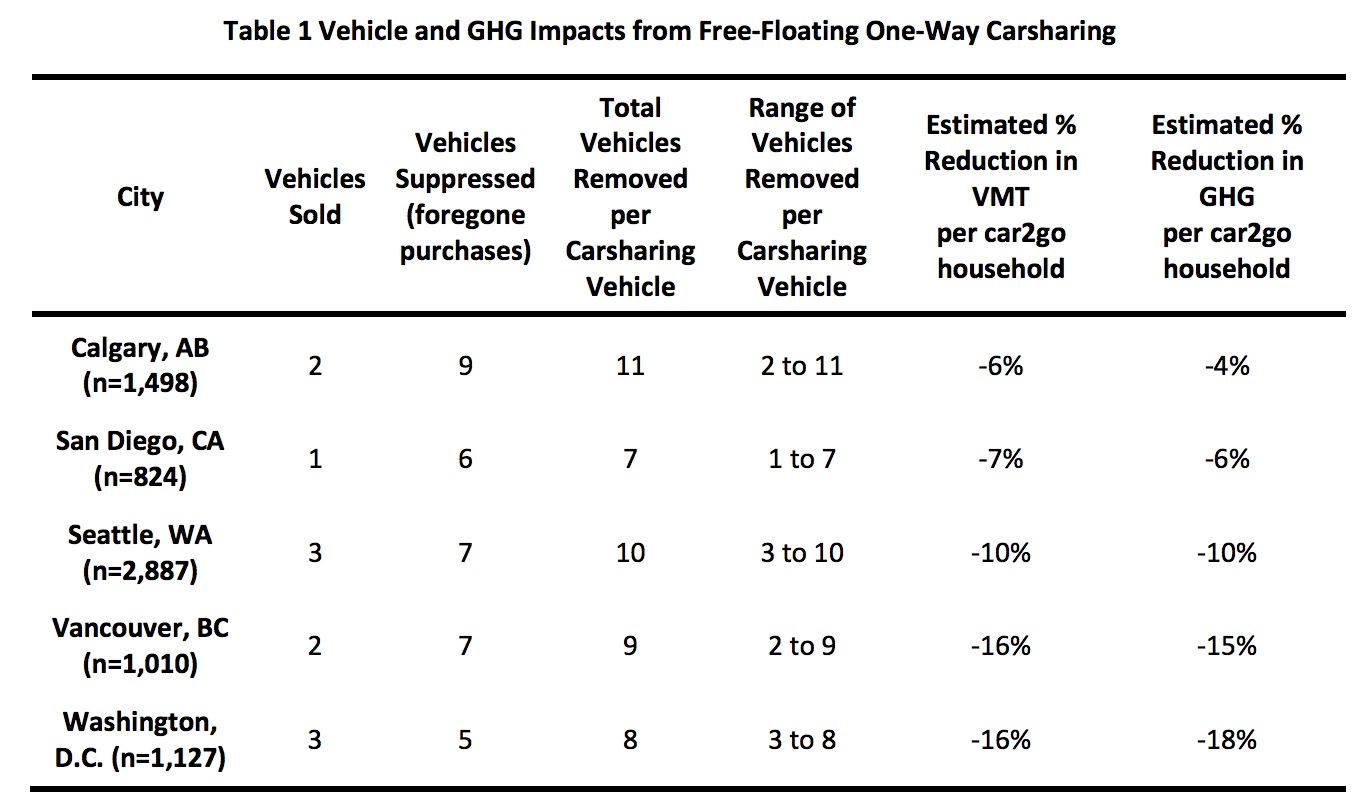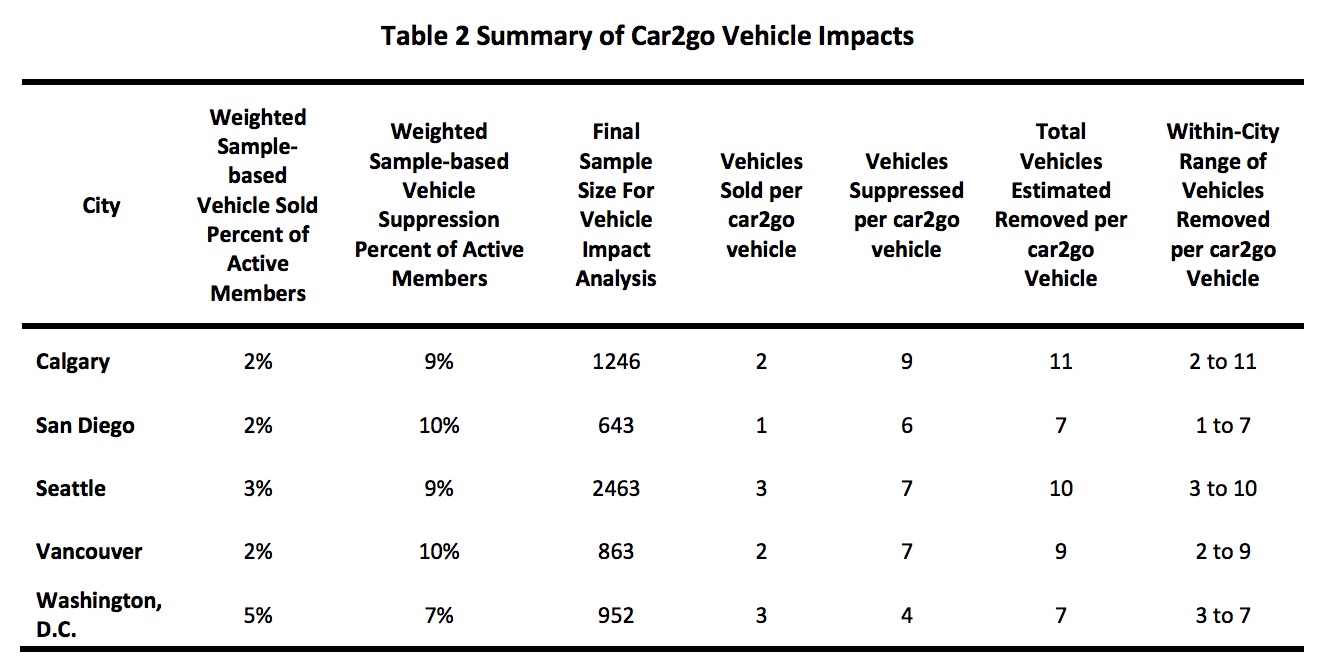TRANSPORTATION SUSTAINABILITY RESEARCH CENTER
Impacts of Car2Go on Vehicle Ownership, Modal Shift, Vehicle Miles Traveled, and Greenhouse Gas Emissions: An Analysis of Five North American Cities
Executive Summary
Carsharing is the shared use of a vehicle fleet by members for tripmaking on a per trip basis. There are four forms of carsharing in North America today: 1) roundtrip, 2) one-way, 3) peer-to-peer, and 4) fractional. In roundtrip carsharing, members begin and end a trip at the same vehicle location and typically pay for use by the hour, mile, or both. One-way carsharing enables members, who pay by the minute, to begin and end a trip at different locations—either throughout a free floating zone or station-based model with designated parking locations. Peer-to-peer carsharing functions much like roundtrip carsharing; however, the vehicle fleet is typically owned/leased by private individuals and facilitated by a third-party operator. Finally, the fractional ownership model enables users to co-own a vehicle and share its costs and use. Roundtrip carsharing has been operating in North America for over 20 years. In July 2015, there were 39 roundtrip carsharing operators in North America with a total membership of 1,005,893 and a collective fleet of 18,582 vehicles. In 2010, one-way carsharing launched in North America in Austin, Texas with the car2go service. As of July 2015, there were three one-way operators in North America, serving 511,000 members with a collective fleet of 6,870 vehicles (Shaheen and Cohen, 2016, forthcoming).
Car2go is currently the largest carsharing operator in the world, with a presence in nine countries and nearly 30 cities. It operates as a one-way instant access carsharing system within a pre-defined urban zone. Members can find an unoccupied parked vehicle, access it immediately, and use it to meet their local travel needs. As long as the vehicle is parked within the operating zone, users only pay for the time that they drive. As a one-way system, car2go provides flexibility to the user. There are questions as to whether one-way carsharing increases overall vehicle miles traveled (VMT), by facilitating easier one-way travel (and automotive commuting) within urban environments. The results of this study suggest that access to ubiquitous shared automobiles allows some residents to get rid of a car or avoid acquiring one altogether. These actions taken by a minority of members have VMT-reducing effects that are estimated to exceed the additional driving that does take place within car2go vehicles. This study surveyed car2go members in five cities to determine the impacts on vehicle ownership, modal shift, VMT, and greenhouse gas (GHG) emissions. The cities surveyed were Calgary, San Diego, Seattle, Vancouver, and Washington, D.C. We asked questions that required respondents to attribute specific changes in their life as caused by the presence of and access to car2go. We also used vehicle activity data to evaluate the total driving that car2go vehicles travel in a city during a year, as well as a profile of the frequency of use by the broader car2go population.
Not surprisingly, we found that car2go has a diverse range of impacts on the member population. Most of the car2go population appears to use it for a small number of trips a year to satisfy incidental mobility needs. This activity generally adds to driving that is additional or would have otherwise occurred with another automobile. The analysis also found that a minority of the population uses car2go as a substitution for personal automobiles as they either sold personal vehicles owned or suppressed the acquisition of a private auto. The impacts of these changes are large relative to the overall increase in driving that is caused by car2go activity. Thus, the results of this analysis suggest that car2go is on net reducing vehicles that would be owned by households, reducing driving, and thus lowering GHG emissions.
There are diverse impacts on travel behavior; the magnitude of these impacts varies across the five cities; and the results are subject to some measurement uncertainty. The study asked modal shift questions that show the relative shares of respondents that changed their use of other modes in response to car2go. car2go was found to both substitute and complement public transportation, as well as other active transportation modes, such as walking and to a lesser degree bicycling. In most cities, a majority of members exhibit no change in public transit use due to car2go. But among those that do change their behavior, the count of car2go members reducing their public transit use outnumbers the count of those increasing their use. There are exceptions in the cases of both bus and rail, and there are users that make more complementary use of these modes with car2go. In all cities except Washington, D.C., a greater number of members reported walking more due to car2go than walking less. At the same time, car2go had mixed effects on bicycling with smaller magnitudes of change. car2go was found to compete directly with taxis, as most respondents used taxis less as a result. The reported impact of car2go on personal driving also showed mixed effects. In San Diego, more people reported decreasing their driving than increasing it due to car2go, whereas in the other study cities, more people reported increasing their driving than decreasing it. Between 29% and 38% of respondents in four of the cities reported that there was another person with them when they used car2go at least half the time. This question was not asked in San Diego, but it was added as part of the Seattle revisions.
The measurement of mode shift by count of people may differ from the overall cumulative impacts. That is, those driving more due to car2go appear to be doing so in small amounts for incidental uses. While those decreasing driving by selling personal vehicles and avoiding a vehicle purchase are a smaller group. However, this group has a more sizeable impact, which generally overwhelms the additional miles driven on car2go vehicles. This result appears to hold even under some rather conservative assumptions regarding driving displaced from suppressed vehicles. Our analysis also includes consideration of miles driven by staff to redistribute the car2go vehicles. For four of the five cities, staff miles were found to range between 3% and 7.5% of all car2go miles driven. For San Diego, which operated a fully electric fleet of vehicles at the time, staff miles comprised 17% of all miles driven, in part due to the need to shuttle vehicles to depots for recharging.
car2go also causes substantive change on the vehicle holdings of a minority of members. In this study, we measure the change in the raw sample; however, when we scale the impacts to the broader population, we re-weight the effects to consider the distribution of usage frequency in the activity data. This was done to balance the responses in consideration of the fact that more active users are more likely to respond to the survey and are more likely to report substantive impacts relative to the general population. When considering the re-weighted impacts of active car2go drivers (i.e., those using it more than once a month), the results suggest that between 2% to 5% of the car2go population sold a vehicle due to car2go across the study cities. The average age of vehicles sold ranged between 12 and 15.7 years across the five cities, and the entire sample of sold vehicles had an average age of 14.4 years across all of the cities. Another 7% to 10% of respondents (aggregate results) did not acquire a vehicle due to car2go. While these percentages are nominally a small share of the re-weighted sample, at the population level they translate to vehicle reduction impacts that exceed the number of car2go vehicles operating on the streets of the cities studied. We found that members sold between 1 to 3 personal vehicles for each car2go vehicle, and between 4 to 9 vehicle acquisitions per car2go vehicles were suppressed across the cities studied. Overall, car2go removed between 7 to 11 vehicles from the road per vehicle (on average) across the study cities. In aggregate, this estimate translates to about 28,000 vehicles removed from the roads across the five study cities due to car2go operations. In Table 1 below, we provide an overview of key vehicle and GHG impacts in each of the five cities. 
About the Transportation Sustainability Research Center
tsrc.berkeley.edu
The Transportation Sustainability Research Center (TSRC) was formed in 2006 to combine the research forces of six campus groups at UC Berkeley: the University of California Transportation Center, the University of California Energy Institute, the Institute of Transportation Studies, the Energy and Resources Group, the Center for Global Metropolitan Studies, and the Berkeley Institute of the Environment.
Tags: Calgary, car2go, carsharing, D.C., San Diego, Seattle, Transportation Sustainability Research Center, Vancouver, Washington







 RSS Feed
RSS Feed